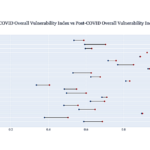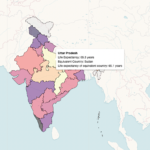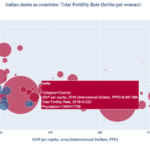HDI: How States Fare in Human Development
National Statistical Office (NSO) recently released a working paper titled Gendering Human Development. It is a working paper for computing Human Development Index (HDI), Gender Development Index (GDI), and Gender Inequality Index (GII) for Indian states.
The theory of measuring human development was developed by Pakistani economist Mahbub ul Haq and this has been further developed to calculate the HDI of a country by the United Nation Development Programme’s (UNDP) Human Development Report Office (HDRO).
According to UNDP, “The Human Development Index (HDI) is a summary measure of average achievement in key dimensions of human development: a long and healthy life, being knowledgeable and having a decent standard of living. The HDI is the geometric mean of normalized indices for each of the three dimensions.”
While GDP measures economic growth of a country, HDI provides a measure to assess human development, i.e., how people’s lives are changing, measured in terms of health and education indicators. Two countries with the same per capita GDP may have different HDI scores. In India, the Planning Commission released the first National Human Development Report 2001 in 2002. States were ranked based on their HDI scores based on 70 development indicators. Kerala was ranked number 2 while Punjab despite its higher per capita income was ranked 19. This shows us how HDI can provide insights into where human development deficits lie and this could be the basis of re-alignment of policies.
The first Global Human Development Report was released by UNDP in 1990 and in 1995, it added the Gender-related Development Index (GDI), and Gender Empowerment Measure (GEM) to the report. GDI also considers the same dimensions and variables as HDI but revolves around inequality between men and women. GEM on the other hand also included three additional variables: women’s participation in political decision-making, their access to professional opportunities, and their earning power.
The Gender Inequality Index (GII) was introduced by the UNDP in 2010 to remedy the shortcomings of GDI and GEM. It measures gender inequality using three dimensions, health – with the help of Maternal Mortality Ratio, and Adolescent Birth Rate, empowerment – on the basis of women’s share of seats in parliament, and population with at least some secondary education age 25+ (in percent), and labour market – based on Labour Force Participation Rate.
HDI and GDI range between zero and one, with values closer to 1 indicating a better score, i.e., higher human/gender development. The interpretation of the GII is the opposite: higher GII shows greater disparities between men and women and lower human development.
In 2001, the National Statistical Commission’s report advocated development of appropriate methodology for computing HDI, and GDI at the state level. It also recommended that studies based on gender related data bring attention to existing gender disparities.
The latest paper released by NSO explains the computation of HDI, GDI, and GII for Indian states for 2017-18. These state-level measures provide us a detailed picture of how human development stands in India across states and where the maximum scope for improvement lies.
Differences between global and Indian measures
HDI and GDI look at three dimensions of human development.
- Long and healthy life: The indicators used to calculate the index for this dimension is life expectancy at birth. This index is called the life expectancy index. These are identical for global and Indian measures.
- Knowledge: The indicators used to compute the education index are expected years of schooling and mean years of schooling. These are also the same for global and Indian measures.
- A decent standard of living: Global HDI and GDI use Gross National Income (GNI) Per Capita (2011 PPP$) to calculate the GNI index. The Indian measure of HDI uses Per Capita GSDP to calculate the income index, while for GDI it uses Estimated Earned Income (male and female) Per Capita Per Annum (Rs) [1]
There is no difference between dimensions and indicators used to calculate GII globally and in India. The three dimensions are:
- Health: Maternal Mortality Ratio, and Adolescent Birth Rate
- Empowerment: Women’s share of seats in parliament, and population with at least some secondary education age 25+ (in percent)
- Labour market: Labour Force Participation Rate
The paper released by NSO shares both HDI, GDI, and GII scores for states and India and the dimension-wise scores as well.
Human Development Index
The aggregated HDI score for India (as calculated by the NSO) has improved from 0.635 in 2011-12 to 0.672 in 2017-18. According to the UNDP, India’s HDI in 2018 was 0.647 which went down to 0.645 in 2019. India’s dimension-wise score is given in Table 1
Table 1

HDI Across States
HDI is divided into four categories: Very High HDI (HDI score of 0.800 or more), High HDI (0.700 to 0.799), Medium HDI (0.550 to 0.699) and Low HDI (below 0.550). Figure 1 shows Indian states with their HDI scores in 2011-12 and 2017-18
Figure 1
To view a state’s HDI or GDI or GII score in 2011-12 or 2017-18, first select the index in the first dropdown in the top right corner then select the year and click on any state to find its score, category or rank
According to the latest state-wise scores, India has no states in the Low HDI category in the 2017-18 rankings. In 2011-12, Bihar was the only state in this category. Out of 36 states and Union Territories (UTs), 19 are in the Medium HDI category. These include Gujarat, Andhra Pradesh, West Bengal, and Uttar Pradesh. In 2011-12, 24 states and UTs were in this category.
14 states are included in the High HDI category. This includes 6 states and UTs (Punjab, Haryana, Karnataka, Telangana, Meghalaya, and A&N Islands) that have been included in the High HDI category in 2017-18 but were in the Medium HDI category in 2011-12. At 0.775, Kerala has the highest HDI score in this category. In 2011-12, 10 states were included in the High HDI category.
Delhi, Chandigarh, and Goa are three states and UTs that are included in the Very High HDI category with scores above 0.800. In 2011-12, Chandigarh, and Goa were in the High HDI category. Delhi tops India with the highest HDI score of 0.839.
Delhi’s high HDI score is driven by a high score across the three sub-indexes: health, education, and income. With 0.842, Delhi has the second highest score on the health index in the country (Kerala is ranked first with 0.849). Delhi also scores high on the education index with a score of 0.749 (Only Chandigarh, and Mizoram are ranked ahead of Delhi in education with scores of 0.790 and 0.757 respectively). Delhi is also ranked second on the income index with a score of 0.936 (Goa is ranked first with a score of 0.979).
Gender Development Index
The aggregated GDI score for India has improved to 0.876 in 2017-18 from 0.809 in 2011-12. According to the UNDP, India’s GDI score was 0.829 in 2018. India’s dimension-wise GDI score is given in Table 2. We find that on the health index, while the male score has decreased from 0.752 in 2011-12 to 0.735 in 2017-18, the reverse has happened for the female score. Similarly, the male score for the education index has registered a decline while the female score has improved.
Table 2

GDI Across States
According to the NSO paper, “States/UTs are grouped into five categories based on the absolute deviation of GDI from gender parity, 100*|GDI – 1|.” Since 1 is the maximum value, it indicates perfect gender parity. Deviations from 1 measure how far the state is from gender parity.
Group I: High Equality (Absolute deviation from gender parity less than or equal to 2.5%). Five states and UTs are ranked in this category in 2017-18. These are Goa (ranked 1), Himachal Pradesh, Chandigarh, Sikkim, and Mizoram. No state or UT was categorized as a Group I state in 2011-12.
Group II: Medium High Equality (Absolute deviation between 2.5 – 5 %). Meghalaya, A&N Islands, and Kerala are the three states or UTs classified as states with Medium High Equality based on their GDI scores. No states or UT was classified as such in 2011-12.
Group III: Medium Equality (Absolute deviation between 5 – 7.5 %). Five states or UTs, Punjab, J&K, Delhi, Daman & Diu, Lakshadweep are categorized as Medium Equality states in 2017-18. Only Sikkim, and Meghalaya were included in this category in 2011-12.
Group IV: Medium Low Equality (Absolute deviation between 7.5 – 10 %). Uttarakhand, Maharashtra, Haryana, Tamil Nadu, Andhra Pradesh, Gujarat, Dadra & Nagar Haveli, and Rajasthan are included in this category in 2017-18. Three states were included in this category in 2011-12. All three have improved their categories in 2017-18.
Group V: Low Equality (Absolute deviation above 10%). 15 states or UTs are included in the Low Equality category. This includes Karnataka, West Bengal, Uttar Pradesh, and Bihar. This number is down from 29 in 2011-12.
Figure 1 also shows Indian states categorized based on their GDI scores in 2011-12 and 2017-18. Select GDI in the first dropdown and click on a state to check its score, rank, and category in a year.
Daman & Diu has registered the highest improvement in GDI rankings between 2011-12 and 2017-18. Its rank has jumped 22 places, from 34 in 2011-12 to 12 in 2017-18. Arunachal Pradesh has seen the biggest decline in rank, from 13 in 2011-12 to 29 in 2017-18.
Gender Inequality Index (GII)
GII measures gender inequalities in three important aspects. As explained earlier, these are:
- Health: Maternal Mortality Ratio, and Adolescent Birth Rate
- Empowerment: Women’s share of seats in parliament, and population with at least some secondary education age 25+ (in percent)
- Labour market: Labour Force Participation Rate
GII informs us about the position of women in states and UTs and shines light on areas of gender gaps in human development. This helps create suitable policy interventions to remove these gaps.
Table 3 shows us India’s aggregate GII scores for all three dimensions for 2011-12 and 2017-18. We see a significant reduction in the Labour Market Index for Females in 2017-18.
Table 3

GII Across States
States are put under five categories based on their GII scores. These are Category I (below 0.400), Category II (0.400 to 0.499), Category III (0.500 to 0.599), Category IV (0.6 to 0.699), Category V (0.7 and above).
Five states (Andhra Pradesh, Himachal Pradesh, Jammu & Kashmir, Maharashtra, and Tamil Nadu) are in Category I in 2017-18, signifying low gender inequality. In 2011-12, only Himachal Pradesh and Punjab were in Category I.
14 states find themselves in Category II in 2017-18, up from 8 in 2011-12.
12 states or UTs were placed in Category V (signifying high inequality) in 2011-12. 9 remained in this category in 2017-18 as well.
Punjab saw its rank drop from second in 2011-12 to fifteenth in 2017-18 owing to a steep drop in percentage share of seats held by women in Parliament and Female LFPR.
Delhi (Category II) may have lost points as its Maternal Mortality Ratio was not available and it was computed using average values of neighboring states, Haryana and Uttar Pradesh. Similarly, Chandigarh may have lost points as its MMR was computed using the average of values for Punjab, and Haryana. [2]
Select GII in the first dropdown in Figure 1 and year in the second dropdown to check a state’s GII score.
Conclusion
While UNDP’s annual HDI score tells us about the improvement in human development in India, this calculation of states’ HDI, GDI, and GII shows how these indices have changed over time and reveals gaps in human development in the states. While per capita GSDP remains an important marker of economic development, HDI, GDI, and GII scores inform us of how this economic prosperity is changing people’s lives on the ground. It reveals increasing equality or inequality between states, regions, or genders.
According to 2017-18 rankings, there is no Indian state in the low-HDI category. While this is a good development, we also find that states like Bihar, Jharkhand, and Uttar Pradesh continue to lag significantly behind other Indian states like Kerala, Goa, or Himachal Pradesh. In GDI, the decline in health and education index for males is a worrying development. In GII, the sharp decline in LMI for females is also a troubling change.
Another major concern in calculation of states’ HDI, GDI, and GII is the gap in data collection for various states or UTs. The absence of Maternal Mortality Ratio for Delhi or Chandigarh raises concerns about India’s official channels of data collection and raises question marks about these rankings. There also remains scope for improvement in calculating Gender Inequality Index with respect to female empowerment. While UNDP uses women’s share of seats in parliament to calculate empowerment, India should also consider women’s share of seats in state legislatures to draw a fair picture of this aspect of female empowerment.
HDI, GDI, and GII remain important measures of human development but still provide scope for improvement, both in calculating human development, and making policy choices to improve these scores.
[1] Estimated earned income (male and female) is worked out from Per Capita GSDP and share of wage bill derived from 68th round 2011-12 (Employment and unemployment Survey) and Periodic labour Force Survey 2017-18.
[2] P 12, Gendering Human Development, NSO
If you wish to republish this article or use an extract or chart, please read CEDA’s republishing guidelines.







